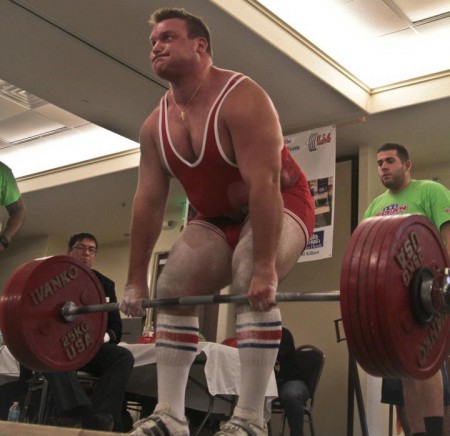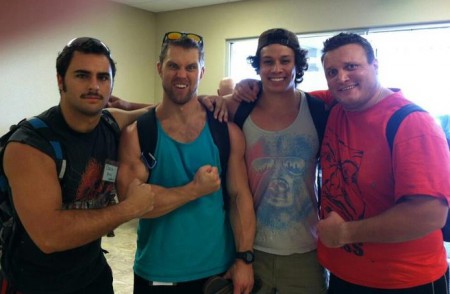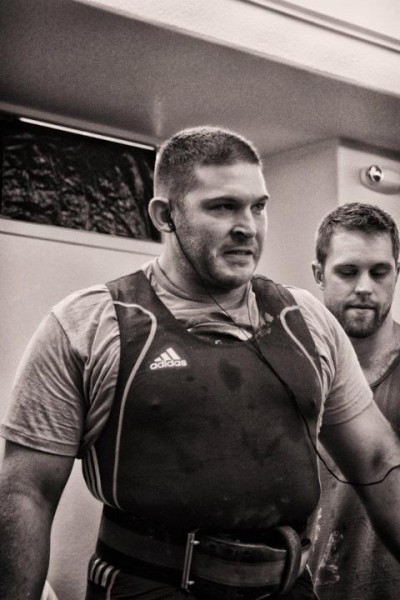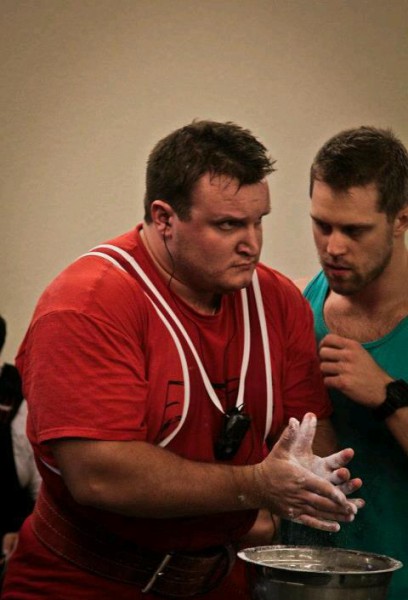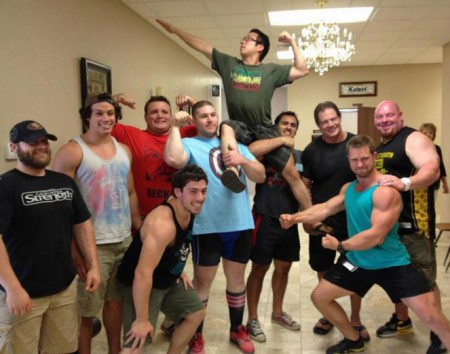I’m often asked when my next competition will be. I love competing in lifting, and I will always lift throughout my life, but right now I’m not committed to competing in lifting. Other things like hobbies, writing, running a business (I run all facets of my business, albeit poorly), and coaching get in the way of entering a meet or competition. Until you’ve traveled for almost two months straight and only get to train several times or pull 12 hour days to write a book, you won’t understand that. It used to bother me that I wasn’t a top weightlifter or powerlifter, but I’ve come to accept it and not worry about it. These days, I channel that energy into other outlets, such as trying my luck across all sweepstakes casinos online for a different kind of thrill. But I think people forget — and I sometimes do too — that I compete all of the time.
This past weekend I coached 11 lifters; I competed 11 times. Those lifters had 99 attempts; I competed 99 times. Each of those lifters had warm-ups, psychological factors, and physical variables that had to be accounted for. I don’t merely count attempts and push them to the platform; I try to manage their life. It may be that what I do doesn’t have as much of an effect as I think it does, and it may be that the lifter doesn’t ever notice what I do, but I’m constantly evaluating them and making decisions on their behalf to perform optimally and get the most out of what they can do on that day. I competed all weekend.
For me, coaching is competing. I get adrenaline spikes for each lift, and they are higher than any psyche up I’ve had in my own lifting in at least a year. The difference is that I have to stay in the moment and try to minimize error. In 2010 when Chris missed his last deadlift, I literally took a walk and cried because I was so spent physically and emotionally from coaching. Pretty dorky. Nowadays, I do that three days in a row with more than twice as many lifters. Someone asked me why I opted to handle so many people. I don’t get to sleep, I don’t get to eat, and I really don’t get to hang out with my friends. The only conclusion I can come up with is because it’s a challenge, it’s a competition. That’s the first lesson.
There were ups and downs over the weekend. My philosophy as an athlete and a coach has always been, “Let’s find out what went wrong, then figure out what we need to do to fix it.” Remember our lifters from the meet recap (Part 1 and Part 2): Courtney, Wendy, Brent, Sean, Jordan, Andrew, AC, Norman, Drew, Mike, and Chris.
Second Lesson – “National Meet Syndrome”
Raw Nationals is a big meet, and it’s run differently than local competitions. If you’ve never been to one, you won’t really understand how it’s different. In truth, it’s still a powerlifting meet, but it’s the human psyche that builds it up to more than it is. And even if you think you are immune to it, you will fall victim to the fact that it’s not the same as your local USAPL meet. Here’s why.
You traveled to the meet. If you get on an airplane to go compete, you are automatically at a deficiency from what you normally are at home. It’s because you had to go to the airport, dick around in security, sit down on a plane for a while, and eat shitty food. If you’re traveling by air, then you are staying in a hotel for at least one night and your food intake is inherently different than when you’re at home.
You cut for the meet. If you are still relatively new to cutting for a meet (fewer than five times), then this process will be debilitating, even if it’s only a few pounds. It may be that you are slightly physically weaker due to losing weight. But it’s more likely that you have stressed about making weight, even marginally. People freak out about cutting weight. Even Mike still gets worried; he debated not eating or drinking after 4 PM the night before, I told him not to do that and he still weighed in 1kg/2.2lbs under. The stress of making weight, the unknown, is enough to reduce the ability of a lifter, especially when that lifter is less experienced.
It’s a national meet. Especially your first national meet. Especially if you’re still inexperienced (it was the second meet for several lifters). Automatically most people will be over zealous. They’ll be nervous during weigh-ins, getting their rack heights, and warm-ups. They don’t understand that because of all of these things, but especially because it’s a national meet, they are not going to hit the high end weights that they want to. It’s not that nationals are stressful, it’s that in the back of the lifter’s mind, they know they are going to and at a national meet. That little bit of nervousness or stress is enough that physically and psychologically drains them. This is easily treated with some psychological tactics; I implement these tactics with the regular lifters (but it leaves the scope of this post). I had one lifter tell me that it wasn’t a big deal. I’d like to think it’s because I did my job of keeping them calm (which I was actively doing at all times), but the more experienced people are with competition in general, the less phased they will be from big competitions. There’s no substitute for experience, even if it’s another sport.
All of this means that a lifter should adjust their goals to account for being at a national meet, traveling across the country, and/or cutting weight. A lot of powerlifting mentality comes from geared lifting, and raw lifting is a bit different. First attempts probably need to be lower, and third attempt aspirations need to be lower. Shit, even Chris wanted to deadlift 15lbs more than what he actually did. Wendy opened with a 303 squat and it took her until her 3rd attempt to get a good lift. She only had to jump in the car for a few hours of travel but the fact that it was a national meet, albeit her second one, was still a factor. Accept being conservative at a national meet. Gym PRs are not meet PRs. If you meet PR at a national meet, that is very good.
Third Lesson — Prevent A Weigh-in Fiasco
As a lifter, make sure all of your information is correct. As a coach, triple check this. Andrew wanted to open on squat at 200kg. Whether the judge heard him wrong, or he said it wrong, 220kg was written on the card. Then he signed it. I wasn’t present because I went to eat breakfast, but I still felt responsible (I had already briefed him on what to do and gave him a piece of paper with his openers). I could have rectified this by triple checking his opener on the board, but I didn’t. I sure as fuck will forever in the future.
Also, Chris’ second bench was set for 611. Brad Gillingham, Chris’ hero, came up to him and said, “Hey man, are you actually opening with 611 on bench?” Chris said, “Yeah…nah, I’m just kidding. They put it up wrong.” In this case, it was correct on the attempt card but put into the computer wrong (it was his squat opener).
Also, double check equipment before and after the equipment check-in. This is not exactly our fault, but AC’s socks were cleared at equipment check-in and on his first attempt (there’s a judge that stands there specifically to check the attire of the lifter and they will notify you if anything is amiss). On the second attempt, she said his socks were not high enough. This, by the way, is fucking bullshit. Don’t accept them at the check-in and on the first attempt. And if you do, take us out to dinner first, because I like to be wined and dined before I’m FUCKED IN THE ASS. While another judge would apologize for this, as a coach I’m not going to allow socks that are questionable. Check the equipment, don’t let the socks touch the knee sleeves, and don’t wear underwear or spandex under the singlet (you might be sneaking some squat briefs).
Fourth Lesson – Third Attempts
Only 4 of 11 lifters made their third attempt squat. Courtney, Wendy, AC, and Mike did. Sean missed his because we went for a record (probably a bit more of a jump than normal, had to pull the trigger though). Andrew didn’t have a chance to do his because of the “wrong opening attempt” fiasco, so he’s not a good data point. Drew is a shitty data point because he was not actually squatting correctly. I just realized I forgot to recap Drew’s meet — SORRY DREW. He had this hunkered over squat with the bar two inches below the crease of his armpit. This means that his torso was inclined forward more than 45 degrees, and that does not fly in USAPL, at least not at the stricter national meet. In any case, he had a crack at an attempt on the third attempt after changing the bar position and standing up more to get a rack command, but the squat was high. He is not a good data point because it was literally the weirdest thing I’ve ever seen and unacceptable in the meet. Brent, Norman, and Jordan missed there thirds, and for each of them I would point to the programming leading into the meet. Jordan and Chris were more mechanical issues — they both came forward slightly to not engage their posterior chain and didn’t have hip drive. So 4 of 9 lifters made their attempts, and 3 of those 5 that missed can easily hit a third with modifying their program.
5 of 11 people made their third bench, but two of the misses were due to injuries, so it’s more like 5 of 9. Courtney, Brent, Sean, Andrew, and Chris made their thirds. AC and Mike missed due to injuries. Then Wendy, Jordan, Norman, and Drew — the four who missed and didn’t have an injury — all had reasonable jumps. Had I planned Wendy’s attempts I probably would have gotten her a third, but she had hit openers and went based on feel. The rest of the fellas just had 5kg jumps after second attempts that were around moderate difficulty.
4/11 made their third deadlifts. Two misses are artificial here. Wendy actually locked out her third attempt, but she hitched it on the way because she didn’t have baby powder on (my fault). Mike missed his third because it rolled his singlet up and got caught on it. Those are two issues that are easily correctable. So 5 of 9 legitimately missed. Courtney’s miss was due to her programming; she didn’t have any high intensity pulling (it was low intensity, high volume), and that has to be there for powerlifting. Brent, Andrew, Drew, and Norman missed because of their programming. Deadlift, more so than the other lifts, has to be trained so that the body can lockout heavy pulls when it’s already fatigued. Norman in particular was completely exhausted; he hadn’t done a meet since December, I think. The other guys just missed weights that should have been doable (all the weights were below what they wanted to hit) because they hadn’t trained specifically to hit a third dead. Brent even said that he hadn’t deadlifted a lot in training.
Let this be a lesson. Unless you are specifically doing things to account for third attempt possibilities in training (which is taught and explained in The Texas Method: Advanced), then plan on more conservative attempts. Everyone, except for Mike, always has an unrealistic view of what they want to hit. I mean, Courtney was talking about hitting 375 (she’s done it before, not in a meet), and she finished with 325 (missed 353, which is doable with proper programming). AC and Chris weren’t unrealistic because we decided what we wanted to hit a couple of months ago, though Chris still was hoping high for his deadlift.
Just trust me on this. This lesson ties in intimately with the second lesson: the fact that it’s a big meet means you won’t do as well. That could be the case for a variety of reasons, but that’s just the way it is. Until you have done a few of these big meets, you will fall victim to this reality, so plan around it. I’ll be talking more about this in the future.
The Lessons
Like I said, there were ups and downs. When you look at the completion numbers, it’s not exactly pretty. However, four people medaled (were at least top 5), Mike was a singlet malfunction away from 5th place, and AC was 15kg away from 5th place (doable with a healthy shoulder and a chance on what we wanted for the third deadlift). Two younger guys bombed out, one because his attempt was wrong (and I didn’t fix it) and the other because he’s squatted silly all year. 6 people qualified for the Arnolds, and if Brent hit one more lift he would have qualified (I should have kept an eye on this, but no one was talking about it that day).
1. It’s a competition for everyone, so everyone has to be on their toes. I learned a lot as a coach that will help me prevent a lot of the bad things that people had to go through.
2. National meets mean the lifter won’t lift as much. That’s just how it is unless they are experienced. Plan around it.
3. Triple check everything. This will prevent any equipment or attempt card malfunctions. And then check them again.
4. Since lifters won’t lift as much, plan the third attempts accordingly. A small PR is still a PR, and it’s better than missing a lift. Account for malfunctions with baby powder and get singlets out of the way.
If you guys have any questions about this meet, or other meets, drop them in the comments. The meet was awesome, there were a lot of big lifts. Powerlifting legend Brad Gillingham, possibly one of the best super heavyweights in history and has pulled over 800 pounds in over 80 competitions, competed and only placed second! Kimberly Walford was red lighted on a 507 deadlift (she locked it out) in the 148 pound weight class. Ian Bell deadlifted 705 on his second attempt in the 198 weight class and LOST (made 2nd place). Our friend AJ Lareto deadlifted 650 in the 198 class and only placed FOURTH. This is raw lifting, folks, and the standards are strict. It’s a good show.

